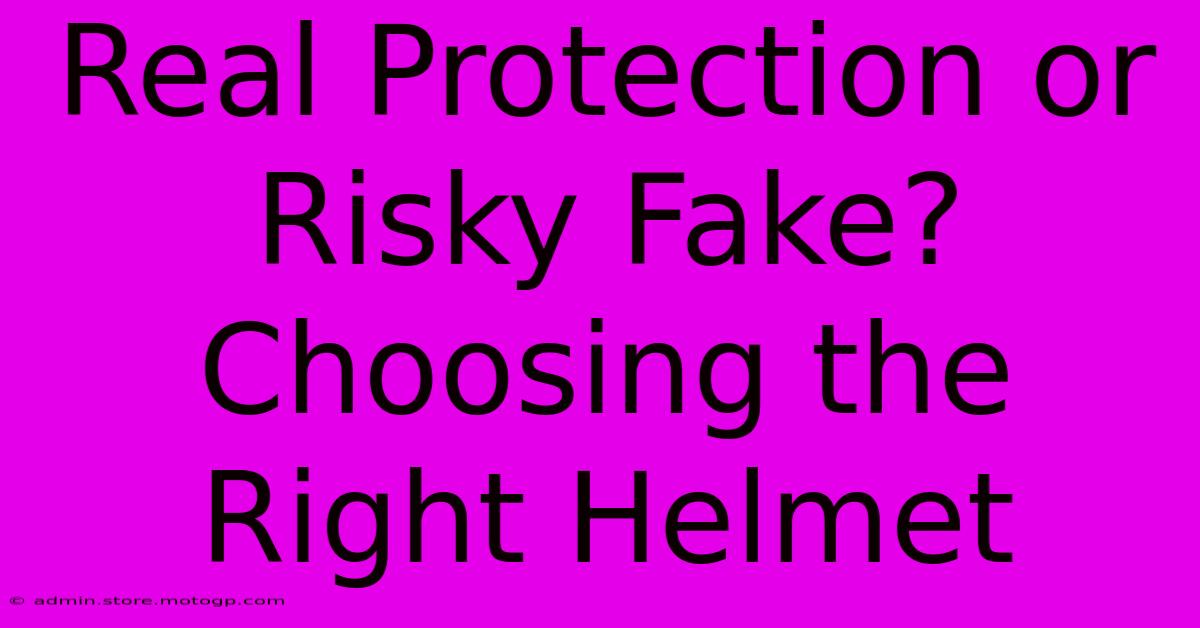Real Protection Or Risky Fake? Choosing The Right Helmet

Table of Contents
Real Protection or Risky Fake? Choosing the Right Helmet
Choosing the right helmet can mean the difference between a minor scrape and a life-altering injury. Whether you're a cyclist, motorcyclist, skateboarder, or even a construction worker, your helmet is your first line of defense. But with so many helmets on the market, how do you separate the real protection from the risky fakes? This guide will help you navigate the world of helmets and make an informed decision that prioritizes your safety.
Understanding Helmet Standards and Certifications
Before you even consider the style or color, you must understand the importance of safety standards and certifications. These standards indicate that the helmet has undergone rigorous testing to meet specific safety requirements. Look for these certifications:
- DOT (Department of Transportation): This is a US standard, indicating the helmet meets minimum safety requirements for use on motorcycles and other motorized vehicles.
- ECE 22.05 (Economic Commission for Europe): A widely recognized European standard, often seen on helmets sold internationally.
- Snell Memorial Foundation: This is a more stringent standard than DOT, indicating a higher level of protection. Snell-certified helmets often undergo more demanding impact testing.
- ASTM F1492 (American Society for Testing and Materials): This standard is commonly found on bicycle helmets and sets specific requirements for impact absorption and protection.
Don't compromise on safety! A helmet lacking a reputable certification is a significant risk. While it might seem cheaper upfront, the potential consequences of inadequate protection far outweigh any savings.
Identifying Fake Helmets: Red Flags to Watch Out For
Counterfeit helmets flood the market, posing a serious danger. Be vigilant and look out for these red flags:
- Unusually low price: If a helmet is significantly cheaper than comparable models, it's a major warning sign. Legitimate manufacturers have production costs, and drastically underpriced helmets are often fakes.
- Poor quality materials: Examine the helmet closely. Look for uneven stitching, loose straps, flimsy construction, or cheap-looking plastic.
- Missing or unclear certification labels: A lack of proper certification labels is a huge red flag. Fake helmets often mimic certifications or lack them entirely.
- Vague or nonexistent branding: Legitimate brands have clear and consistent branding. If the branding is unclear, misspelled, or inconsistent, it's suspicious.
- Suspicious online retailers: Be wary of purchasing helmets from unknown or unreliable online retailers. Stick to reputable retailers with established return policies.
How to Verify Authenticity:
- Check the manufacturer's website: Many manufacturers provide ways to verify the authenticity of their helmets. Look for a serial number or other identifying features you can check against their database.
- Contact the retailer: Ask the retailer about the helmet's authenticity and request proof of certification.
- Consult consumer protection agencies: If you suspect you've purchased a fake helmet, contact your local consumer protection agency for advice.
Choosing the Right Helmet for Your Activity
The best helmet for you depends heavily on your activity:
Motorcycle Helmets:
- Full-face helmets: Offer the best overall protection, covering the entire head and face.
- Modular helmets: Combine the protection of a full-face helmet with the convenience of a flip-up chin bar.
- Open-face helmets: Offer less protection than full-face helmets, but provide better ventilation.
Bicycle Helmets:
- Road bike helmets: Typically lightweight and aerodynamic, prioritizing speed and efficiency.
- Mountain bike helmets: Often feature more robust construction and additional protection features like visors.
Skateboard, Scooter, and Rollerblade Helmets:
- These helmets usually prioritize impact absorption and feature a robust outer shell.
Construction Helmets:
- These are designed to protect against falling objects and impacts, typically made from durable materials like hard plastic.
Remember to always try on a helmet before buying it to ensure a proper and comfortable fit. A helmet that doesn't fit properly won't provide optimal protection.
Maintaining Your Helmet
Regular maintenance is crucial to prolong the lifespan and effectiveness of your helmet. Follow the manufacturer's instructions for cleaning and storage. Always replace a helmet after a significant impact, even if there's no visible damage. The internal structure may be compromised, leaving you vulnerable.
Choosing the right helmet is a critical decision. By understanding helmet standards, identifying fake helmets, and selecting the appropriate helmet for your activity, you can significantly increase your safety and peace of mind. Don't compromise on your safety – choose real protection.

Thank you for visiting our website wich cover about Real Protection Or Risky Fake? Choosing The Right Helmet. We hope the information provided has been useful to you. Feel free to contact us if you have any questions or need further assistance. See you next time and dont miss to bookmark.
Featured Posts
-
F1 Grid Strategies How Teams Utilize Grid Formula 1
Feb 20, 2025
-
Yamaha V4 Engine The Ultimate Choice For Boaters
Feb 20, 2025
-
The Anatomy Of Speed Moto Gp Horsepower Deconstructed
Feb 20, 2025
-
How Fast Is Moto Gp At Catalunya
Feb 20, 2025
-
Cota Merchandise A Must Have For Every Fan
Feb 20, 2025
